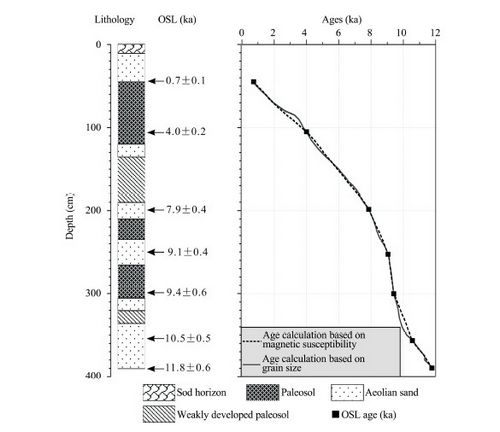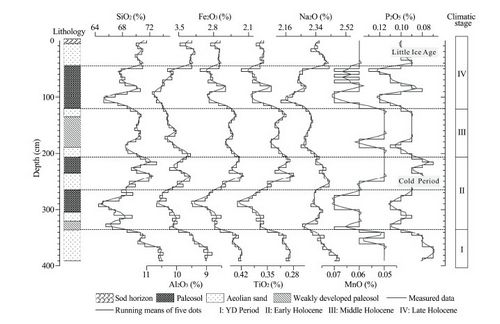Geochemical evidences of dry climate in the Mid-Holocene in Gonghe Basin, northeastern Qinghai-Tibetan Plateau
Updatetime:2013-04-02From:
【Enlarge】【Reduce】
The Middle Holocene is regarded as a warm and humid period, accompanied by increased Asian monsoonal strength and higher temperature and precipitation.The researcher synthesized massive deposits and characteristics of climatic proxies and indicated that the temperature and humidity reached an optimum condition following the increasing Asian summer monsoonal strength in 8.0–3.5 ka BP (14C age); this period is defined as the Megathermal Maximum in the Holocene or the Holocene Optimum period. Paleoclimatic and paleoenvironmental evidences from northeastern China, the Yellow and Yangtza river basins, and subtropical and tropical areas have also shown the broad extent of the Holocene Megathermal period.However, there are different opinions regarding the Megathermal Maximum in the Holocene with optimum warmth and humidity in the Asian monsoon’s boundary zone. Recently research demonstrates a relatively arid Mid-Holocene in southeastern Mongolia,and the Alxa Plateau. A lake study from the Qaidam Basin also revealed a decline in moisture at that time. However, there is little research on whether there was an optimal condition in the Mid-Holocene in the northeastern Qinghai-Tibetan Plateau (the northwest fringe of the modern Asian monsoonal region).Hence, the main objective of this research was to study the arid climate in the Mid-Holocene in Gonghe Basin based on profiles of aeolian sand and paleosol, using OSL dating and characteristics of lithology and geochemical parameters.
Previous research on climatic change in the Mid-Holocene in China indicates that it was a warm and humid period, accompanied by stronger summer monsoons, and it is defined as the Megathermal in the Holocene, or the Holocene Optimum period. However,this conclusion is mainly directed at the monsoonal region in eastern China. In this research, the researchers chose the Gonghe Basin in the northeastern Qinghai-Tibetan Plateau as the study area. Geochemical analysis of the profiles of paleosols and aeolian sand in the Santala area in the middle of the Gonghe Basin, along with OSL (optically stimulated luminescence) dating, indicates that the regional climate has experienced several warm-humid and cold-dry cycles since 11.8 ka. In particular, the Mid-Holocene (8.1–4.6 ka) was relatively cold and dry as evidenced by drastic fluctuations in chemical weathering degree and humidity, a higher aridity index, and sparse vegetation, accompanying increased winter monsoonal strength. In order to clarify whether this is an individual or local signal, we compared our geochemical analysis results with lake and peat records and aeolian deposits of the monsoonal boundary region. The results indicate that the climate deteriorated widely, with declines in temperature and moisture, in the Mid-Holocene in the modern monsoonal boundary zone. Furthermore, the duration of climate deterioration (relatively dry period) generally decreased from west to east in the aforementioned regions. Therefore, this dry phase in Gonghe Basin may be representative of dry events in Mid-Holocene in northern China. In addition, we discuss the reasons for this dry climate from several perspectives: (1) it probably can be attributed to a decline in summer monsoonal strength; (2) the regional evaporation loss (forced by high temperature) was not compensated by regional precipitation; (3) the thermal dynamic effect of the Qinghai-Tibetan Plateau.

Lithology and relationship of the ages with depth in the LG profile

Variation of the content of chemical elemental oxides with depth in LG section, Gonghe Basin
Download from the attachment




